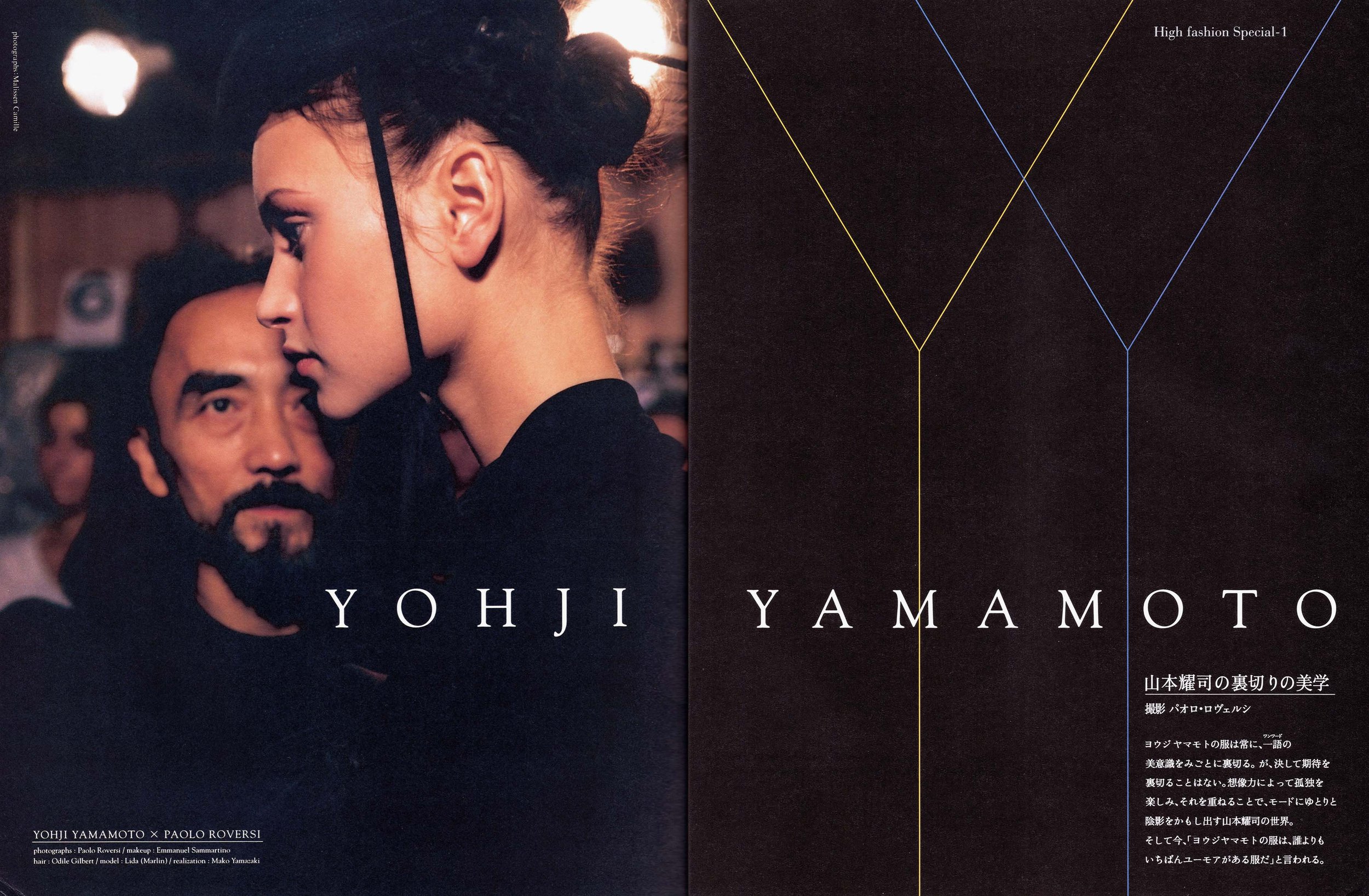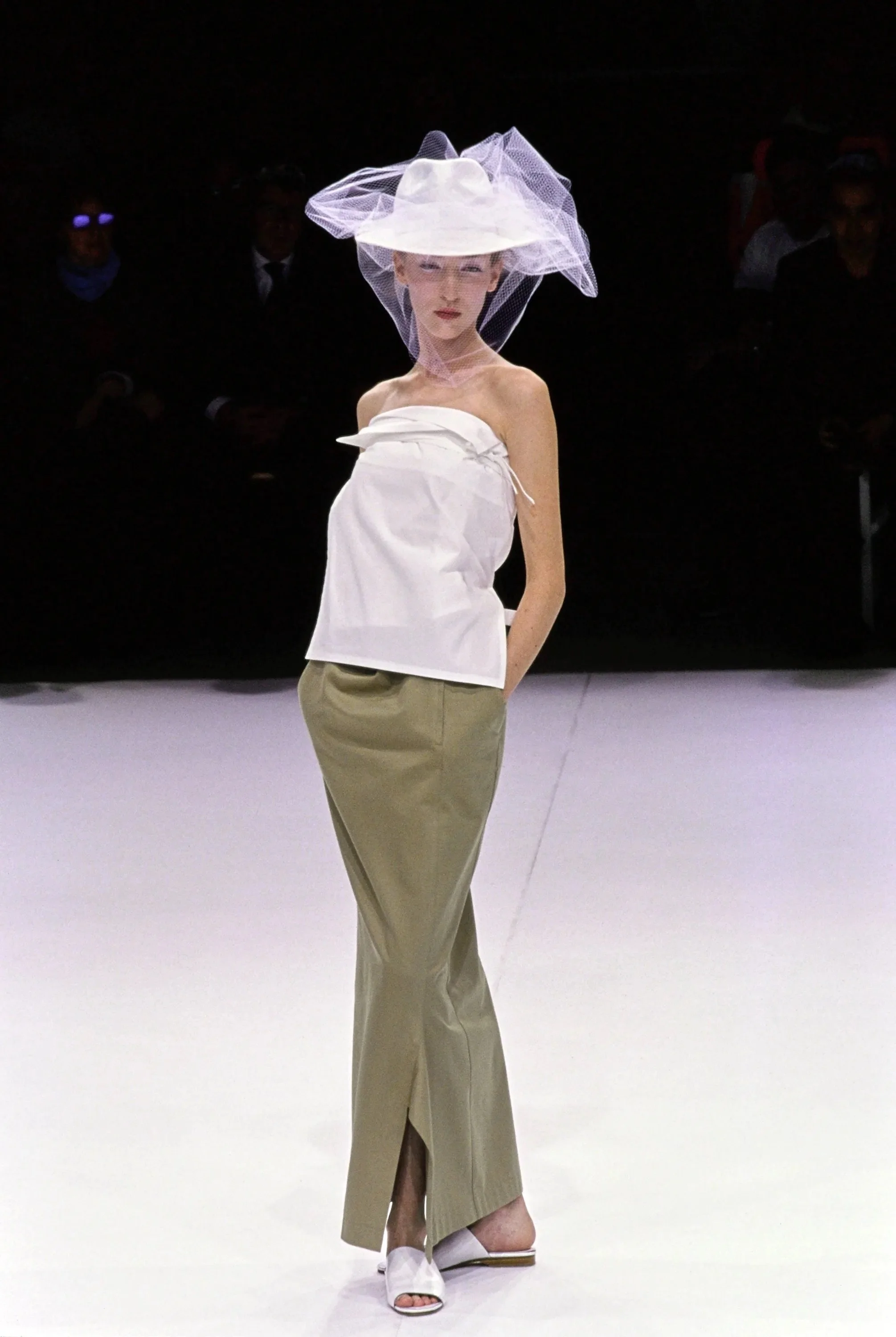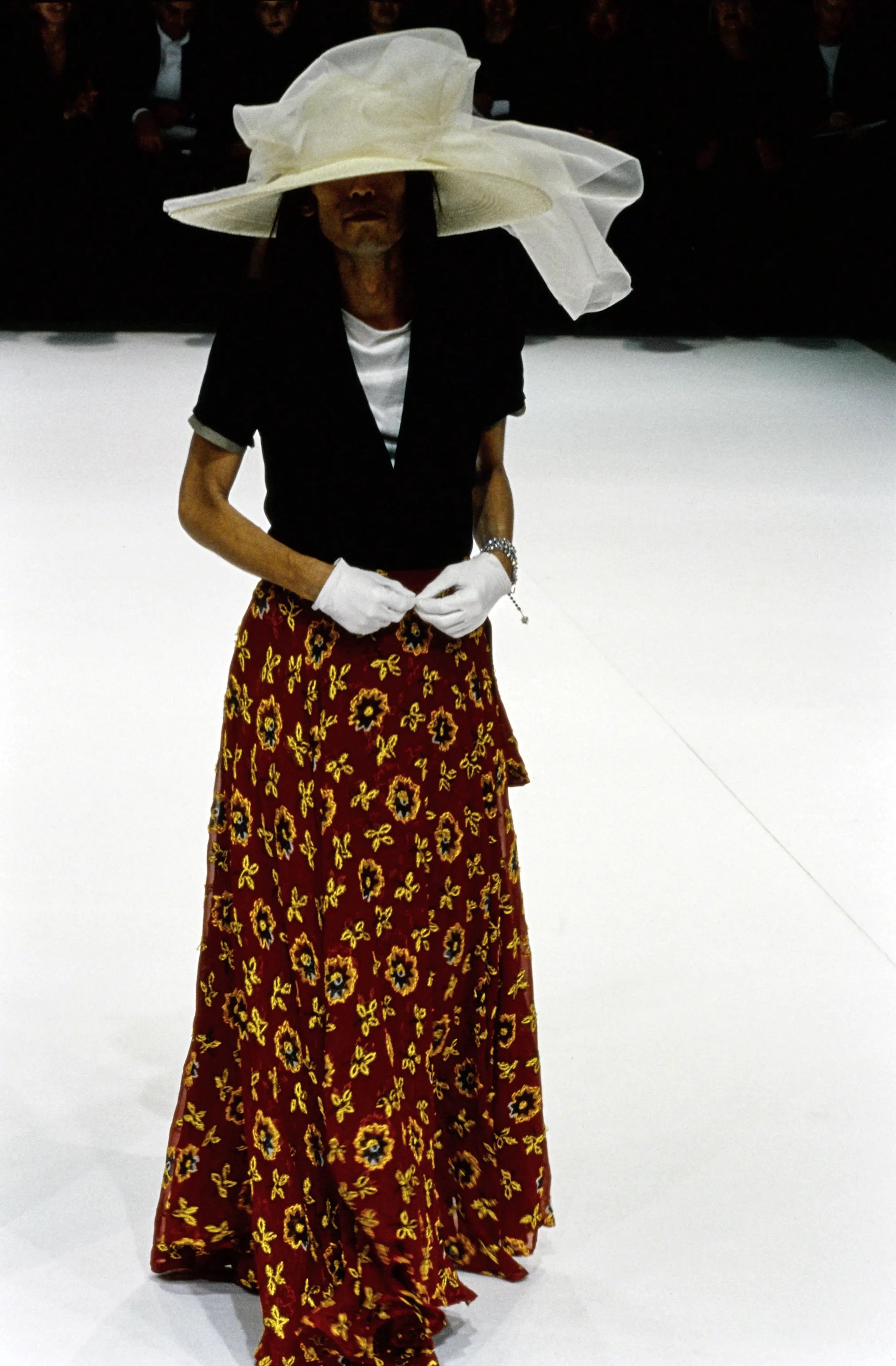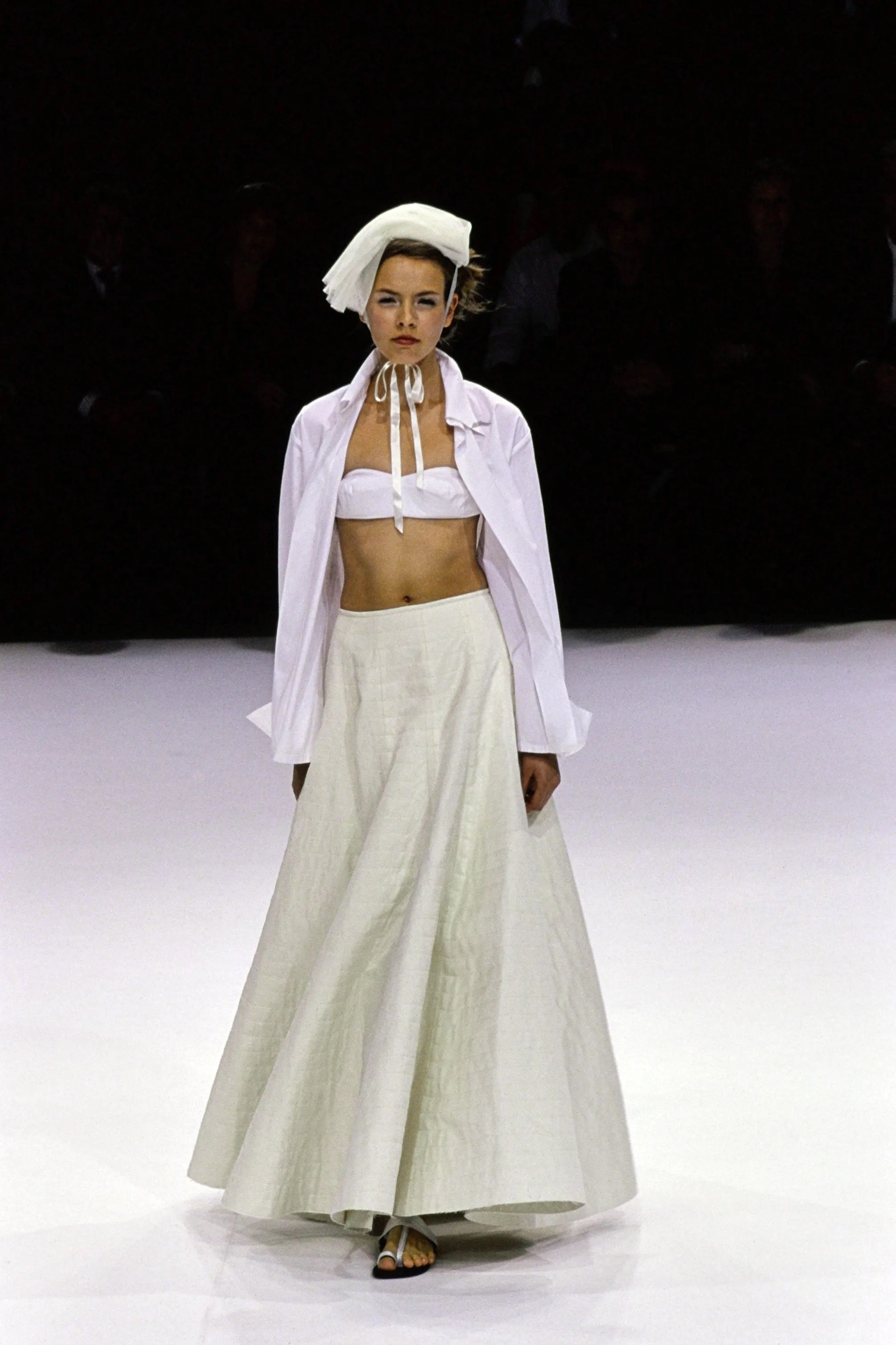Yohji Yamamoto
Spring/Summer 1999
Yohji Yamamoto Collections
2014
Yamamoto & Yohji
Published by Rizzoli
A story of joyful, sad, rebellious, brides or merry widows... From the 'inflatable' pneumatic dress to the dress with 'secret drawers', to the most intimate 'striptease'. A jubilant and touching moment of grace.
Yohji Yamamoto’s Transformative Wedding Collection
January 23, 2014
Style.com
The invitation was to a wedding, but Yohji Yamamoto's Spring 1999 collection was bridal as bridal had never been before. "Behind the wedding dress, there must be many stories," Yamamoto said, and as the ones he showed told theirs, literally changing before the audience's eyes, many in the front row dissolved into tears. Tim Blanks revisits one of the most enchanting fashion shows ever, a career high from a modern master.
山本耀司の裏切りの美学
Yohji Yamamoto's aesthetics of betrayal
February 1999
High Fashion No.265
Photography by Malissen Camille
ヨウジヤマモトの服は常に、一語[ワンワード]の美意識をみごとに裏切る。が、決して期待を裏切ることはない。想像力によって孤独を楽しみ、それを重ねることで、モードにゆとりと陰影をかもし出す山本耀司の世界。そして今、「ヨウジヤマモトの服は、誰よりもいちばんユーモアがある服だ」と言われる。
Yohji Yamamoto's clothes always betray the one-word sense of beauty. However, they never betray expectations. The world of Yohji Yamamoto, who enjoys solitude through his imagination and through the layering of such imagination, creates a sense of space and shades of meaning in fashion. And now, it is said that "Yohji Yamamoto's clothes are the most humorous clothes of all."
YOHJI YAMAMOTO × PAOLO ROVERSI
February 1999
High Fashion No.265
Photography by Paolo Roversi
Makeup by Emmanuel Sammartino
Hair by Odile Gilbert
Modelling by Lida (Marlin)
Realization by Mako Yamazaki
私がヨウジの服を好きな理由:フランカ・ソッツァーニ
Why I like Yohji's clothes: Franca Sozzani
February 1999
High Fashion No.265
Report and text by Miyuki Yajima
Photography by Shin Shin and Ernest Leve
アイロニーに富んだ服
「ヨウジヤマモトのコレクションは、’81年から現在まで継続して見ています。パリでは、そのころは、まだ展示会をしていなかったと思います。セバストポール通りにある建物の最上階の一室で販売が行なわれていました。あるブティックの経営者に勧められて、そこへ見に行ったのです。その時には、レインコートなどを買いました。
初めてヨウジの服に袖を通したときの印象は、今でもよく覚えています。〝変わった感じ〟がしましたね。服の構造が他と全く異なるので、服に手を通したときの感じが、それまでの経験とは全く違っていました。あの時の不思議な驚きは今もなお記憶に残っています。
翌’82年に、当時編集長をしていた、やはりコンデ・ナスト社の〝Lei〞で、日本人デザイナーの特集を組みました。覚えていますか。〝日の丸〟が表紙になっていた号です。
服の伝統があろうとなかろうと、天才デザイナーは、どの国からも生まれえます。ヨウジの服づくりの発想は、日本の方法ではないでしょう。キモノシリーズもありますが、大方は西洋のオートクチュールのほうにより近い存在だと思います。ただ、西洋のデザイナーと違うのは、カットです。テキスタイルのリサーチも違っています。
ヨウジは、レイ・カワクボやイッセイ・ミヤケとともに服を作る手法をすっかり変えてしまったのです。ショーのあり方、カット、ルック、テキスタイル、すべての要素において。これまでの西洋の服装史の流れの中で、最も重要な革命を引き起こしたといえましょう。
中でもヨウジの服は、たいへんアイロニーに富んでいます。心の底から楽しんで服を作っていることがうかがわれます。そこが、私がヨウジを好きな理由なのです。その楽しみのセンスに富むことを、私たちはアイロニーに富むと言います。
彼は、あらゆるタイプの服を作ることができるでしょう。オートクチュールの一点としての服も作りうるでしょう。ところが、彼はそこに大いなるアイロニーを込めるのです。と、とたんにモダン極まりない服になる。人は〝アイロニー〟にあまり重点を置かないかもしれませんが、〝アイロニー〟こそは、あらゆるものをモダンにする鍵なのです。
ヨウジが、アイロニーなしで、真っ向からまじめにコレクションに取り組んでしまったら、彼のショーは即座に舞台衣装になってしまうでしょう。〝アイロニー〟の力は避けることができません。〝アイロニカルである〟というのは、インテリジェンスのあらわれです。
今回のコレクション(’99春夏)もすばらしかった。まるで夢を見ているようでした。全く予想もつかないような内容でしたね。
過去に今回のヨウジのような服の見せ方をしたデザイナーは、一人としていませんでした。アート、テアトロ、音楽、詩、情熱、歴史、技術等、すべてがありました。
人はよく『美しいけれど着られない』と言ったりします。でも、今回のヨウジの非凡さは、一枚ずつ脱いでいく服のすべてが、それぞれ着られるものなのです。売れる商品であり、同時に夢の世界のように型破りでエキセントリックなんです。実に贅沢極まりないコレクションでした。
服はほうっておくとたまる一方なので、時折処分するのです。でも、ヨウジの服は、コム デ ギャルソンやアライア、ゴルチエ、そしてサンローランの服とともに、一点も捨てることなく、全部保管しています。だから、ヨウジの服はたくさん持っているのです。写真を撮るのですか。それでは、最も鮮やかな色、黒のヨウジを着ましょう」(談)
Clothes Rich in Irony.
"I have been looking at Yohji Yamamoto's collection continuously from 1981 to the present. I don't think there were any exhibitions in Paris at that time. The sale was taking place in a room on the top floor of a building on Boulevard de Sébastopol. I went to see it at the recommendation of a boutique owner. At that time, I bought a raincoat and other things.
I still remember the impression I had when I first put my sleeves through Yohji's clothes. It was a 'different feeling'. The structure of the clothes was completely different from others, so the feeling I had when I put my hands through them was completely different from anything I had experienced before. I still remember the strange surprise I felt at that time.
The following year, in 1982, I was editor-in-chief of Conde Nast's 'Lei,' and did a feature on Japanese designers. Do you remember it? The issue had the Hinomaru on the cover.
Genius designers can come from any country, regardless of whether there is a tradition of clothing or not. Yohji's conception of clothing making is probably not the Japanese way. He has a kimono series, but for the most part, he is closer to Western haute couture. However, what is different from Western designers is the cutting. Textile research is also different.
Yohji, along with Ray Kawakubo and Issey Miyake, has completely changed the way clothes are made. In every element: the show, the cut, the look, the textiles. It is arguably the most important revolution in the history of Western clothing to date.
Yohji's clothes are especially rich in irony. It is evident that Yohji enjoys making clothes from the bottom of his heart. This is the reason why I like Yohji. We call it rich in irony when one has a sense of enjoyment.
He will be able to make all types of clothes. He could also create clothes as a piece of haute couture. However, he puts great irony into it. Suddenly, the clothes become extremely modern. People may not put too much emphasis on 'irony', but 'irony' is the key to making everything modern.
If Yohji approached his collection head-on and seriously, without irony, his show would instantly turn into stage costumes. The power of 'irony' cannot be avoided. 'Ironical' is an expression of intelligence.
This collection (Spring/Summer 1999) was also amazing. It was like I was dreaming. It was completely unexpected.
No single designer has ever presented clothing the way Yohji did this time around. There was everything: art, theatrics, music, poetry, passion, history, technology, etc.
People often say, 'It's beautiful, but not wearable.' But what's extraordinary about Yohji this time is that each piece of clothing, taken off one by one, can be worn individually. It's a product that sells, but at the same time it's unconventional and eccentric, like something out of a dream world. It was truly a luxurious and extravagant collection.
Clothes tend to accumulate if left alone, so I get rid of them from time to time. However, I keep all of Yohji's clothes, along with Comme des Garçons, Alaïa, Gaultier, and Saint-Laurent clothes, without throwing away any of them. That's why I have a lot of Yohji's clothes. Are you taking pictures? Now, let's wear the most vivid color, black."
ヨウジヤマモト バックステージ:’99年春夏パリ・コレクション
Yohji Yamamoto Back Stage: ’99 Spring/Summer Paris Collection
February 1999
High Fashion No.265
Photography by Malissen Camille
山本耀司の目の前に、モデルたちが最後のフィッティングに現われる。今回のショーは、ロシアや東欧から来た無名のモデルが多い。彼女たちの研ぎ澄まされたシルエットに透明感が漂う。
モデルたちの動きの中にドレスを見つめる山本耀司の柔和な目が、鋭く服を射る。ドレスのどこかにニュアンスの違いを発見したのだろうか。突然服が変えられる。そして素早く縫製スタッフが手直しを始めた。
「ウェディングドレスは人生のドラマを背負っている」と2か月前、山本耀司は語った。「白いドレスの花嫁の誰もが幸せを迎えるとはかぎらない。メリー・ウィドーになる人もいるだろうし⋯⋯」黒衣の花嫁は、人生の光と影でもあるのだろう。「僕が問いかけたいのは、ビーチサンダルに普段着の若い二人が突然教会に飛び込んできて、花嫁はレースを頭にかぶっただけで結婚式を挙げる。それでもいいじゃないかと⋯⋯」
1998年、10月17日、午後8時30分。場所はムーラン・ルージュ。ショーの幕は上がった。次々とユーモラスに展開するウェディングドレスの祝祭。その知的な美の悪戯の中にふっと人間の愛と生と死という根源的なテーマがよぎった。
Models appear for the final fitting in front of Yohji Yamamoto. This season's show featured many unknown models from Russia and Eastern Europe. These women's polished silhouettes suggest a sense of transparency.
Yohji Yamamoto's gentle eyes look sharply at the dresses as the models move. Did Yohji discover mistakes in the nuances somewhere in the dresses? Clothes suddenly change. The sewing staff quickly begins to make alterations.
"Wedding dresses carry the drama of life," said Yohji Yamamoto two months ago. "Not all brides in white dresses will find happiness. Some may become merry widows..." Perhaps the bride in black is also the light and shadow of life. "What I wanted to ask is, if two young people suddenly burst into a church in flip-flops and everyday clothes, and the bride has her wedding ceremony with just lace on her head: is that okay..."
October 17, 1998, 8:30 P.M. The location is Moulin Rouge. The curtain rises on the show. A celebration of the wedding dress that unfolds with humor. In the antics of this intellectual beauty, the fundamental themes of human love, life, and death are flashing by.
1999春夏パリ・プレタポルテコレクション
Paris Prêt-à-Porter Collections 1999 Spring-Summer
February 1999
High Fashion No.265
Photography by Shin Shin and Koichiro Matsui
Report by Ikuko Fujii, Misako Tamagawa, and Naoko Ikuta
今シーズンのフィナーレを飾ると言ってよいショーは、モンマルトルのムーラン・ルージュで発表。テーマは「結婚」。ウェディングマーチが流れる中、現われたモードは、ウェディングドレスの歴史を感じさせるコスチューム性とモダンな日常着の二面性を持つ。クチュールのテクニックが駆使され、とりわけ波打つフレアのフォルムは構造主義的。男女が逆転した装い、ファスナーを開け、ポケットから次々に小道具を出していくドレス⋯⋯。ユーモアも交え、ロマンティックでエレガントな女性像を演出。
The show, which can be said to be the finale of the season, was presented at the Moulin Rouge in Montmartre. The theme was "Marriage". As the wedding march was playing, the fashion that emerged had the dual aspects of a costume that evokes the history of wedding dresses and modern everyday wear. Couture techniques are fully utilized, especially in the structure of the billowing flares, which are reminiscent of structuralism. At one point, gender roles were reversed, and, later, a dress had zippered pockets from which props were taken out one after another... With a touch of humor, the romantic and elegant image of a woman is created.
1981/2002
2002
Yohji Yamamoto: Talking to Myself
Published by Steidl/Carla Sozzani
パリコレ30年の軌跡
30 Years of Paris Collection
March 2011
FASHION NEWS Special Vol.161
「ウエディング」がテーマ。反抗的で陽気な寡婦、悲しげな花嫁、幸せな花嫁・・・・・・それぞれの物語を描いた、すべてマリエというシーズン。秘密のポケットがついたドレスからコートや帽子を取り出してモデルが着用するというパフォーマンスも用意された。
The theme was "wedding". A rebellious and cheerful widow, a sad bride, a happy bride... each with their own story, a season calling all mariées. There was also a performance in which models took out coats and hats from dresses with secret pockets and wore them.
Archives Yohji Yamamoto Paris Women’s Collection 1981-’82 Autumn/Winter - 2014 Spring/Summer
2014
All About Yohji Yamamoto from 1968
Published by Bunka Publishing Bureau
Yohji Yamamoto Spring 1999 Ready-to-Wear Collection
August 1, 1998
Vogue
Yohji Yamamoto did two wedding-themed collections in the late nineties, each of them transporting. It’s hard to top a runway-spanning bridal hat that required four attendants, each of them carrying bamboo poles, which he showed for Spring 1998, but he managed it the following year with an enchanting show that had models removing one dress, only to reveal another, and then another. “Behind the wedding dress there must be many stories,” he reasoned. The collection was a career high. Bonus points for the cameo by Vogue’s André Leon Talley.
An Invitation to Yohji Yamamoto's S/S99 Wedding
May 22, 2015
AnOther
Written by Olivia Singer
Photography by Monica Feudi
We explore the haunting beauty and wonderful wit of Yamamoto's S/S99 wedding-themed runway.
Tim Blanks called it “one of the most enchanting fashion shows I’ve ever seen”, and Suzy Menkes termed it the “zenith” of his career. Yohji Yamamoto’s S/S99 collection was one that brought audience members to tears as they simultaneously delighted in its wonderful irreverence; a show that combined the spectacle of fashion with the ritual pageantry of a wedding. With gender roles both celebrated and subverted, the formality of a wedding swiftly transformed into a coquettish explosion of joy, it was simultaneously romantically ethereal and charged with subtext; the embodiment of a designer who consistently brings a cerebral beauty to the runway. Here, we examine what made it just so special.
The Show
With “Here Comes The Bride” playing in the background, a veiled model in a white two-piece suit opened a sequence of breathtakingly beautiful bridal adaptations. In a 1985 interview with Yvonne Baby, Yamamoto explained, “The playful dimension of fashion is very important” and, in 1998, it was the combination of the playful with the exquisite tailoring and drapery that Yamamoto handles with such grace that created the effect. From crinolines and top hats, white shirts and black trouser suits to ballooning strapless gowns, it was an a poetic examination of every element of western nuptial dress through a wonderfully witty lens.
However, far from the pristine, stiff and glistening white of the traditional wedding outfit, the fabrics themselves felt well-worn, floating upon the bodies that modelled them. As Susannah Frankel explains in her biography of the designer, “Yohji’s fabrics were deliberately aged, worn even: in this instance the shock of the new lay in the fact that his work did not actually look new at all. Instead, it appeared imbued with history and hidden meaning.” And the show was drenched with this meaning, with the subversion of the ritual convention and formalities of fashion, of womanhood and of the cermony of weddings. As the show progressed, models started to fling off the gloves that concealed their hands, use tissues pulled from bodices to wipe their mouths, even unzip the white pockets on their crinoline hoop skirts to reveal a practical bridal kit, including flat shoes and a bouquet. As Tim Blanks said, “As the show went on, it got more and more and more delightful. It took the audience somewhere; people were gasping and cheering. The things that happened to the clothing were just magical.”
The People
Malgosia Bela was a picture of traditionally doe-eyed bridal innocence – before she popped on the shoes, chiffon robe and hat that were concealed within the folds of her dress. Shalom Harlow (who, in the same season, was the centrepiece for Alexander McQueen’s industrial graffiti-art show), said that it was “one of my all time favourite shows... I think there was beauty and poetic sadness and laughter and humour.” Vogue’s Editor-at-Large André Leon Talley walked down the aisle to “Je T’Aime” with a stoic expression and a model who can’t help but smile.
The Impact
“In my philosophy, the word androgyny doesn’t have any meaning. I think there is no difference between men and women. We are different in body, but sense, spirit and soul are the same,” stated Yamamoto, and the continual exploration of feminine and masculine conventions are a thread that has been interwoven through his career. During a time where gender binaries are being deconstructed everywhere from Prada to Hood By Air, Selfridges to Gucci, Yamamoto still remains at the forefront of the movement, examining and subverting with both nuance and beauty. His legacy informs an understanding of the codes and rituals that can be explored through fashion, the idea that a serious assessment of societal norms can be performed with the charm and wit that was seen in S/S99.
YOHJI YAMAMOTO S/S 1999
June 10, 2018
Minnie Muse
Written by Colby Mugrabi
On rare occasion, runway shows take place that transcend fashion and into the realm of performance art. While these unique instances occur with increasing scarcity, Yohji Yamamoto’s spring/summer 1999 presentation will forever serve as a preeminent example of such cases, having transported show-goers into a transitory state of uninterrupted artistic bliss.
In the late 1990s, Yohji Yamamoto – fascinated by the complexities associated with the western tradition of weddings – presented two collections inspired by this theme. For spring/summer 1999, the latter of the two shows, Yamamoto maintained his position as a figurehead of avant-garde fashion, all while proving himself a hopelessly modern romantic. The designer showcased his curiosities surrounding tradition through the collection’s abstract narrative and exploration of nuptial dress.
While the show progressed in the manner of a wedding ceremony, with secondary male roles enacted by a select cast of accompanying men – including a cameo by André Leon Talley – abstract ritualistic moments were also conveyed through creative means. Female models sauntered down the open runway, transforming garments and undressing for all to witness. These simple, somewhat erotically driven acts of manipulating silhouettes or removing articles to reveal new garments below, was a creative means of illustrating the layers of stories and underlying intricacies associated with marriage. While the collection’s silhouettes were straightforward and the color pallet remained muted, Yamamoto, furthering his exploration into the various shades of black and white, the designer employed accessories as a primary means of experimentation. From romantic bouquets rendered in tulle and dramatic hats covered in feathers, to subtle while gloves and the occasional neckpiece, Yamamoto touched on every detail of a traditional wedding ceremony, exploring each facet with careful consideration and ease. This remarkable collection personifies the power and artistic potential of fashion, only to be made more moving by the emotional response of the audience, bursting, throughout the show, into episodes of uncontrollable applause.
Yohji Yamamoto S/S 1999
May 4, 2013
StyleJourno
Written by Jake Hall
Yet another iconic collection comes courtesy of Japanese designer, Yohji Yamamoto. Famous for his reluctance to incorporate colour into his collections, his penchant for all things minimalist entered the mainstream in an era in which Italian powerhouses such as Gucci and Versace were dominating the market with their bold, luxe designs. Yamamoto's dedication to his signature aesthetic and eye for tailoring soon gained him a cult following which has continued to develop over the years. 1999's avant-garde presentation has gone down in fashion history as one of the greatest, partly thanks to fashion darling Shalom Harlow (star of McQueen's celebrated 'No.13' show).
One of the main reasons that Yamamoto is so celebrated is that he manages to use texture to add interest to a monochrome colour palette. The overall feel of the collection was one of ethereality - soft black chiffon and white ribbon were amongst the materials used. There was also innovation to be found in the "Secret Dress" - a white bodice with a full white skirt was revealed to have zip-away panels which stored a heavy linen cape, headwear and even white gloves.
The show climaxed with the appearance of the legendary André Leon-Talley, accompanied by a bride that removed a heavy silk cape to reveal Yamamoto's androgynous take on bridalwear. Perhaps a take on traditional gender roles, the "bride" wore high-waisted black trousers with braces and an intricate cream lace blouse, finished with a delicate top hat draped in metres of white ribbon. Following them was a model dressed in a full-length strapless dress which was shown to have a removable corset, once again giving the show the feel of a presentation as opposed to a traditional runway show. As always, Yamamoto chose not to follow the rules - and it worked spectacularly.










































































































































